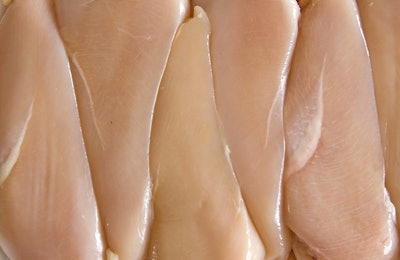
Woody breast is a breast meat myopathy that affects the rigidity, texture and mouth feel of broiler meat. The breast meat may also be a pale color and soft in consistency.
Texture issues can include fibrousness, crunchiness and other unappealing attributes to consumers. Woody breast meat is typically discarded at the processing stage because of its undesirable attributes, resulting in large financial losses.
The myopathy is categorized on a scale of zero to three, with three being the most severe.
Woody breast has become more common with the selection of fast-growing, heavier broilers, although the underlying cause of the condition is still a mystery.
Management strategies
Research suggests that the development of wood breast is linked to an issue at the gut level, therefore, there are several nutritional and management strategies that can help reduce the incidence of woody breast. These include:
- Supplementing with nutrients that affect vasculature and antioxidant properties of the meat (vitamin C or an increased vitamin premix).
- Slowing down the birds by reducing the amino acid density in the grower phase by about 15%
Woody breast detection
Previously, workers at processing plants would attempt to detect woody breast with the hand palpation method. Although very easy to use, this approach is extremely subjective, personnel dependent and depends on the fatigue level, training and motivation of the employee.
Today, there are several new approaches in development that use modern technologies. One method from researchers at Auburn University measures bioelectric impedance analysis to detect woody breast filets in broilers. Other methods use machine-vision, artificial intelligence and accelerometers – the technology uses to measure steps by Fitbits – to identify breast meat with the syndrome.
Strategic positioning
Woody breast meat is not as valuable as meat without the syndrome, but there may be some innovative potential uses or revenue streams for the myopathy regardless.
The syndrome does not affect the entire filet consistently. Typically, the bone side does not exhibit the same characteristics as other portions of the breast, so strategic portioning could be one revenue stream.
Another potential solution is to use woody breast meat in ground meat products, like sausage or hot dogs, which mitigates many of the serious texture issues.


















